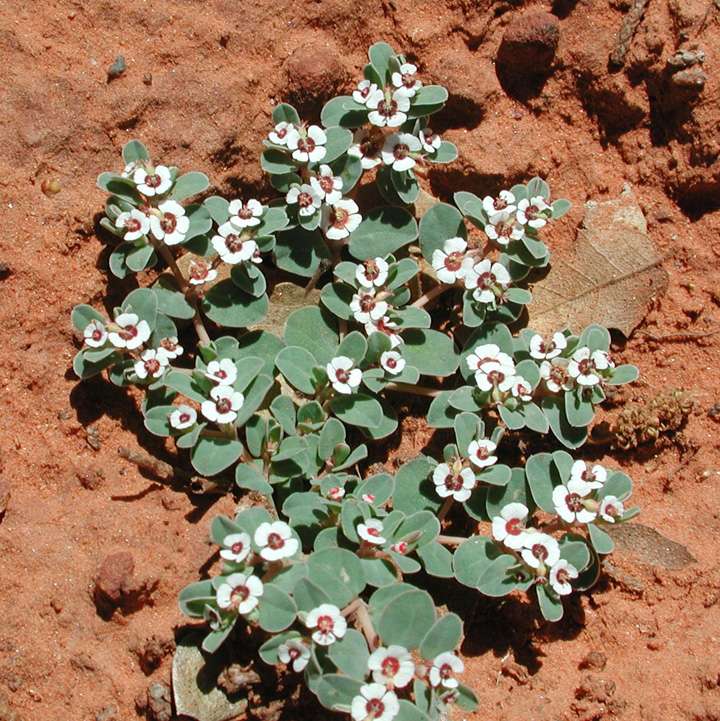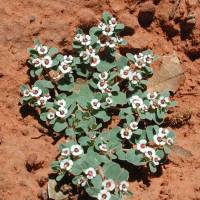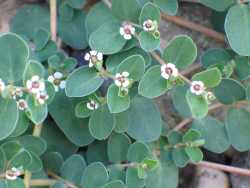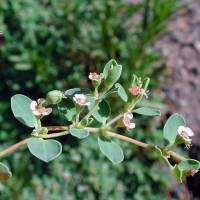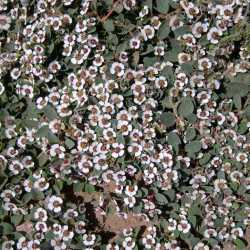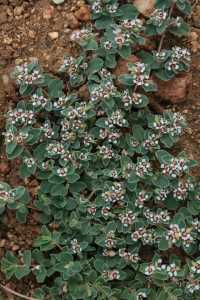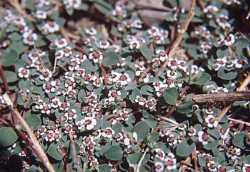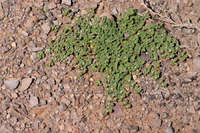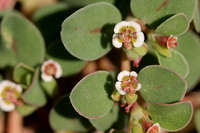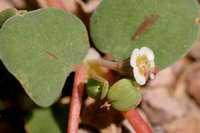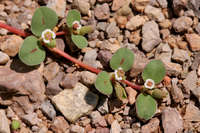Duration: Perennial
Nativity: Native
Lifeform: Forb/Herb
General: Mat-forming perennial herbs with thickened rootstock; stems prostrate and freely branched, 5-80 cm long, often rooting at the nodes; herbage glabrous and often glaucous.
Leaves: Opposite along the stems, on petioles less than 1 mm long; blades orbicular to oblong, 3-8 mm long, with a strongly asymmetric base and entire margins, often with a red blotch in the center; stipules united into a membranous, white, triangular or ovate scale, about 1 mm long.
Flowers: Has the highly modified flower structure characteristic of Euphorbias. Structures called cyathia appear to be individual flowers, but are composed of fused-together bracts forming a cup (involucre), with peripheral nectary glands which are often subtended by petal-like bracts called petaloid appendages. Within the cup there is a ring of inconspicuous male flowers, each reduced to a single stamen. Out of the middle protrudes a single, stalked female flower which lacks petals. In E. albomarginata, the cyathia (modified flowers) are solitary in the leaf axils. Involucres are bell-shaped, and 1 mm high, and glabrous, with 4 green-yellow to red oblong glands around the edge, each with a conspicuous white to pink petaloid appendage which often has a toothed edge; 15-30 staminate flowers.
Fruits: Capsule 3-chambered, broadly ovoid, 2 mm long, glabrous, the angles acute; seeds 4-sided, oblong, smooth and whitish, 1-2 mm long.
Ecology: Found in open, sandy or gravelly dry places up through the pinon-juniper zone, from 1,000-7,000 ft (305-2135 m); flowers April-September.
Distribution: s CA, s NV, s UT, AZ, NM, TX, OK; south to c MEX.
Notes: This species belongs to the Chamaesyce subgenus of Euphorbia. Some treatments, even recent ones, treat Chamaesyce as a separate genus even though molecular evidence places it within Euphorbia. Chamaesyce spp are distinct based on their leaves which are always opposite and and often have asymmetric bases; cyathia (flower structures) in leaf axils, not at branch tips, and usually with petaloid appendages; and stipules present and not gland-like. E. albomarginata is a common and widespread species in the west, distinguished by being a prostrate perennial without any hairs on the stems, leaves, or seed pods; the cyathia (modified flowers) with large white petaloid appendages (look like petals); and stipules that unite to form a white papery scale between the leaf pairs where they attach to the stem (in other species there is a separate stipule at the base of each petiole). The FNA treatment states that the leaves have white margins (hence the specific epithet) but this trait is not particularly obvious on most specimens. It is wise to make a collection whenever ID to species is needed, as Chamaesyces are difficult to identify in the field, and multiple species of the genus will commonly grow side-by-side.
Ethnobotany: Diegueno brew plant into tea to treat sores. Shoshoni and Kawaitsu use leaves and flowers for snakebite. Keres treat eye problems by rub from plant. Navajo use slow tea from whole plant for colds or stomachaches.
Etymology: Euphorbia is named for Euphorbus, Greek physician of Juba II, King of Mauretania, while albomarginata refers to white margins.
Synonyms: Chamaesyce albomarginata
Editor: SBuckley 2010, FSCoburn 2015, AHazelton 2017
Plant: Prostrate perennial forb branching from central point
Leaves: herbage glabrous with milky sap, stipules united into a glabrous, membranous scale
INFLORESCENCE: flower-like, generally 1 per node; involucre < 2.5 mm, bell-shaped to obconic, glabrous; gland < 1 mm, oblong; appendage wider than gland, entire to slightly scalloped, white
Flowers: flowers monoecious borne in cyathia; petaloid appendages white, conspicuous; ovary and capsule glabrous, ~2mm long; seeds smooth.
Fruit: capsule, 2-2.5 mm, ovoid, 3-angled, glabrous; Seed 1-2 mm, oblong, smooth, white
Misc: Dry slopes; < 2300 m.; Apr-Nov


